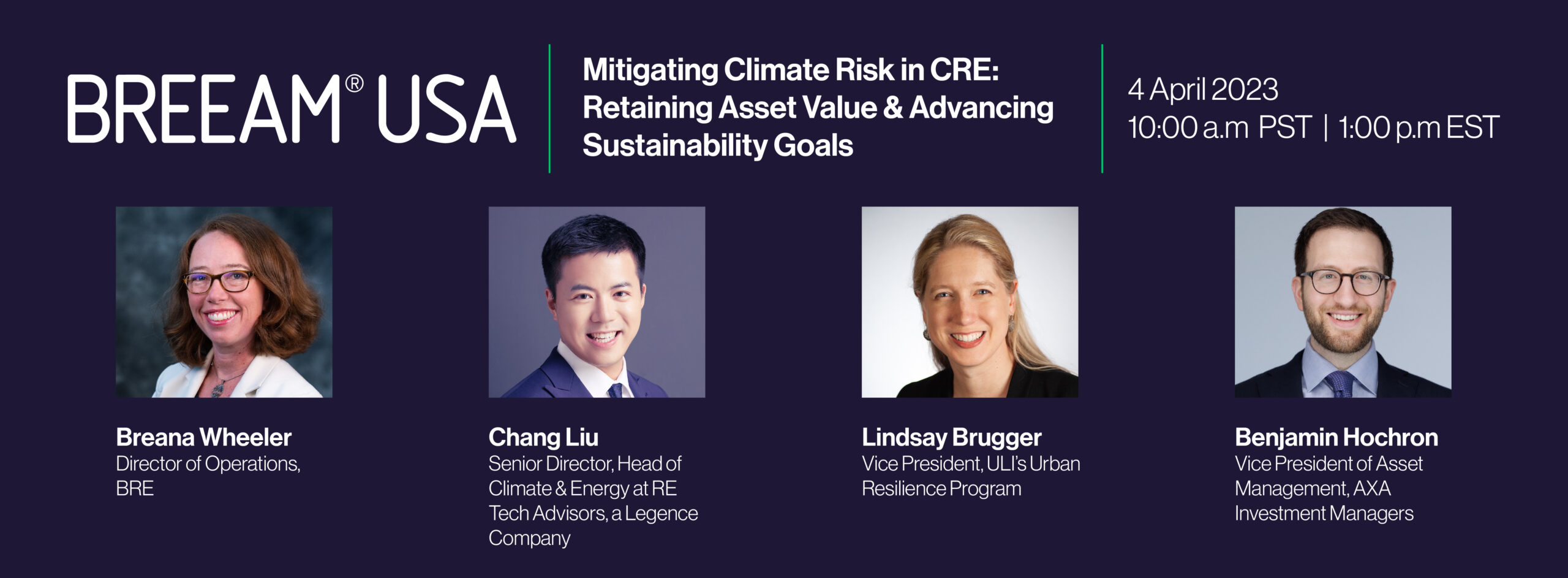In recent years, the commercial real estate sector has significantly bolstered efforts to identify the most pressing climate risks posing a threat to assets and portfolios across the market. However, despite improvements in recognizing the physical and transitional risks that have been brought about by the climate crisis, the focus has remained largely on the (undeniably critical) environmental impact; to provide a more holistic overview of the risks facing the market — and to drive greater action to advance ESG goals — owners and operators in the industry must work to better understand and communicate with stakeholders how these climate risks are having a direct financial impact.
With this in mind, BREEAM USA recently brought together a lineup of industry experts to discuss both the challenges and opportunities around mitigating climate risk, especially as a means of advancing sustainability goals and retaining asset value in the short- and long term.
Panelists included:
- Benjamin Hochron, Vice President of Asset Management at AXA Investment Managers,
- Lindsay Brugger, Vice President of Resilience at ULI
- Chang Liu, Head of Climate & Energy at RE Tech Advisor
The conversation — moderated by BREEAM’S US Director of Operations Breana Wheeler — focused on contextualizing and providing best practices to address the wider business-oriented impacts of climate risk across commercial real estate. Throughout the discussion, the participants leveraged combined decades of sustainability and real estate expertise to highlight several top-of-mind considerations, including:
1. To safeguard asset value, owners and operators should be taking advantage of financial incentives for sustainable improvements and proactively implementing sustainable measures that support resiliency.
“We’re seeing some financial incentives coming to bear to drive sustainable improvements — FM Global recently announced a 5% resilience credit, [which is] going to cost them around $300 million,” shared Lindsay Brugger. “That’s a ton of money for a single company, but they see the ROI — they anticipate $100 billion in savings, a huge benefit-cost ratio. Those customers could see a more stable premium, maybe even a reduction in premium, and [this initiative may] preserve the availability of insurance.”
“Though [an asset] might be located in a high-risk area, understanding what a building already has and what it can do in terms of low-cost implementation measures to increase resilience in a flood or hurricane can be [beneficial for] evaluating insurance — and to assist in a smoother disposition of the asset to a potential buyer in the future,” said Chang Liu.
2. Climate risk assessments can be valuable tools for assessing how an asset’s climate risks may impact the balance sheet; an accurate assessment requires holistic analysis, which can be supported by coordinating with partners who have access to relevant historical data.
“[AXA] has the benefit of being affiliated with a property insurance company. They provide us with data on physical risk and what they’re looking at when they price their insurance policies,” said Benjamin Hochron. “We take into account the major perils of flood, windstorms, and earthquakes — all at the very beginning. The consequential rating that we have is reliable, structural, and based on historical data. It’s helpful to know what the risks are today, and to understand that a medium rating can be a high rating in the future. And if an asset is flagged as medium-to-high risk, we take it a step further with an engineering report or working with a partner firm.”
“Task Force on Climate-related Financial Disclosures (TCFD) reporting drives how we’re evaluating and mitigating risks. We utilize climate analytics platforms to understand what location-based risks could affect [an asset],” shared Liu. “We also look to historical resources — FEMA flood maps and other public resources — to see what events occurred to potentially justify a high risk in the future.”
3. Energy efficiency is a top-of-mind and easily comprehensible first step for improving an asset’s ESG performance and climate risk profile.
“Energy efficiency is top of mind for many stakeholders, and ULI is doing a lot of work with owner-occupier collaboration towards Net Zero Carbon,” said Lindsay Brugger. “There are synergies between traditionally green sustainable measures and what we need in resilience – [dealing with] extreme heat is a perfect example. From a physical risk standpoint, tenants may not be naming it as a climate risk, but they are thinking about it specifically when it comes to business continuity and maintaining that ability to function.”
“Tenants are interested in adding solar on their property -– it helps you get off the grid and gives you more energy independence,” added Hochron. “That’s decarbonization, number one — and it addresses physical risk resilience alongside it. Everyone’s asking for a lot of the same things, just phrased differently or in a different package.”
If you missed the webinar, you can view the recording here.
And if you want to hear more from BREEAM in the US and around the world, sign up for our newsletter to receive the latest news from our world-leading experts and alerts about upcoming webinars and events.

